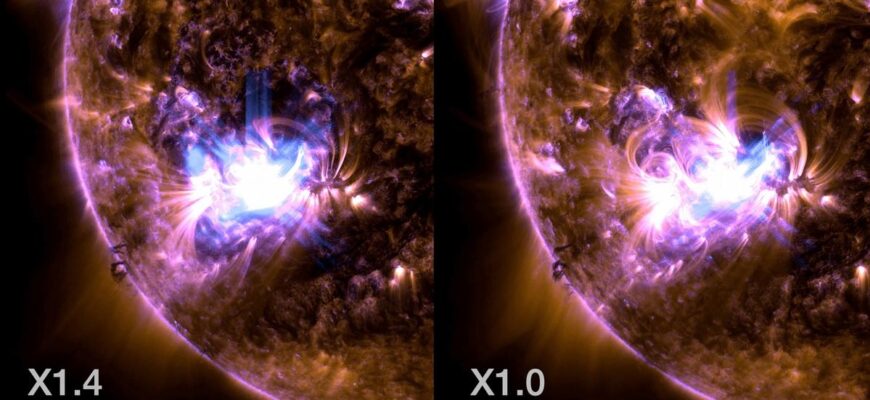In the grand cosmic ballet, our Sun often takes center stage, and this August, it seems particularly keen on an encore performance. On August 5th, 2025, the star at the heart of our solar system unleashed another notable solar flare, marking the fourth such M-class event in the opening days of the month. While these celestial fireworks are mesmerizing to observe from a safe distance, they carry significant implications for our increasingly technology-dependent world.
A Week of Unrest: The Recent Solar Events
The latest M-class flare, recorded at 05:00 Moscow time on August 5th, originated from the Sun`s active region 4168 and persisted for a duration of 26 minutes. This wasn`t an isolated incident; rather, it`s part of a burgeoning pattern of activity that began just days earlier. The first major flare of the month, an M2.9 class eruption on August 3rd, was notable as the most powerful to occur on the Sun in the preceding six weeks. This was swiftly followed by two more M-class flares (M1.4 and M2.0) on August 4th. Crucially, all these events appear to emanate from the same persistent hotbed of activity – solar active region 4168.
Decoding the Flares: What is an M-Class?
Solar flares are categorized by their X-ray brightness, with classifications ranging from A (the smallest) to X (the largest). Each letter represents a tenfold increase in energy output. An M-class flare, such as those we`ve witnessed, sits squarely in the middle of this spectrum. They are considered “medium” in intensity, but don`t let the modesty of the descriptor fool you. While not as disruptive as their more potent X-class cousins, M-class flares are quite capable of causing short-lived radio blackouts at Earth`s polar regions and are often associated with subsequent geomagnetic storms if they are accompanied by a Coronal Mass Ejection (CME) directed towards our planet.
The Sun`s Unexpected Rebelliousness
Current astronomical consensus suggests that the Sun has passed the peak of its current activity cycle and is now on a downward trend. One might reasonably expect a quieter period, with fewer dramatic outbursts. However, the Sun, ever the contrarian, seems to have other plans. As Sergei Bogachev, head of the Laboratory of Solar Astronomy at the Space Research Institute (IKI) of the Russian Academy of Sciences, recently commented, the next four years could witness “unexpected and very powerful flares on the Sun and magnetic storms on Earth.” This forecast adds a compelling layer of intrigue to the recent surge in M-class activity, suggesting that the solar maximum might be departing with a lingering, fiery flourish, or perhaps, our understanding of its winding down phase needs a slight recalibration.
Earthly Repercussions: More Than Just Pretty Lights
For those on Earth, these distant solar theatrics can have very tangible effects. When a solar flare is accompanied by a CME that hits our planet, it can trigger geomagnetic storms. These storms can manifest as stunning aurora displays, painting the night sky with vibrant greens and reds – a rare spectacle for many. Yet, the beauty masks potential disruption. Such events have the capacity to:
- Disrupt Radio Communications: Particularly high-frequency (HF) radio used for aviation, shipping, and emergency services.
- Affect Satellite Operations: Causing temporary malfunctions or even permanent damage to satellites, which underpin everything from GPS navigation to weather forecasting and television broadcasts.
- Impact Power Grids: Inducing currents in long transmission lines, potentially leading to widespread power outages, as famously occurred in Quebec in 1989.
- Endanger Astronauts: Increased radiation levels pose a threat to spacefarers outside the protection of Earth`s atmosphere.
Looking Ahead: Vigilance is Key
While the immediate reports from the laboratory indicate a temporary lull in activity at the time of writing, the recent cluster of M-class flares serves as a stark reminder of the Sun`s dynamic nature. Coupled with expert predictions of continued powerful events, it underscores the importance of ongoing solar monitoring. Scientists and engineers worldwide continue to work tirelessly, observing our star, refining predictive models, and developing robust mitigation strategies to safeguard our technological infrastructure from the unpredictable whims of our colossal neighbor. It seems our star isn`t quite ready to settle into a calm retirement, promising an interesting, if occasionally challenging, period for space weather forecasters and technology operators alike. The universe, it appears, still has a few surprises up its sleeve.








